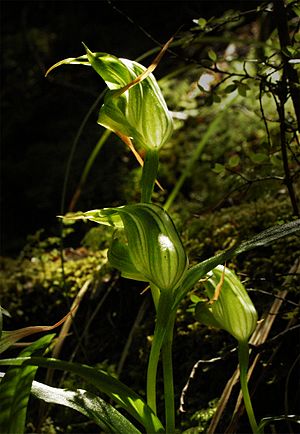Pterostylis irsoniana facts for kids
Quick facts for kids Greenhood |
|
|---|---|
 |
|
| Pterostylis irsoniana growing near the Routeburn Track | |
| Scientific classification | |
| Genus: |
Pterostylis
|
| Species: |
irsoniana
|
Pterostylis irsoniana is a special type of orchid known as a greenhood. It is found only in New Zealand. This plant has a tall stem with up to five leaves. It grows a single dark green flower with white stripes. The tips of the flower often have a reddish color. A unique part of this orchid is its curved lip, called a labellum. This lip has a curled tip and a dark red bump, known as a callus.
What Does This Orchid Look Like?
Pterostylis irsoniana is a plant that grows from the ground. It is a perennial plant, meaning it lives for more than two years. It is also deciduous, so its leaves fall off at certain times. This plant is a herb and has an underground tuber, which is like a small storage root.
It has three to five leaves on its stem. These leaves get bigger as they go up the stem. The largest leaf can be up to 180 mm (7 in) long and 12 mm (0.5 in) wide. The leaves are long and narrow, shaped like a spear. They are green with a hint of red. The leaf at the very top of the stem grows taller than the flower itself.
The plant usually has one dark green flower. This flower often has a reddish color near its tips. The flower grows on a stem that can be up to 350 mm (10 in) tall.
The top part of the flower, called the dorsal sepal, and the petals are joined together. They form a hood shape over the central part of the flower, which is called the column. This hood is known as a "galea." The dorsal sepal is 15–30 mm (0.6–1 in) long. It curves forward and has a short, pointed tip.
The two side sepals, called lateral sepals, stand upright. They stay close to the galea, but their tips spread out a little. The labellum (the orchid's lip) gently curves. Then, it suddenly curls downward at its very tip. It has a dark red or almost black callus, which is a raised bump. This orchid usually flowers from October to January.
How Did This Orchid Get Its Name?
The Pterostylis irsoniana orchid was first officially described in 1950. This description was made by a scientist named Edwin Hatch. He studied a plant sample found at 1,160 m (3,810 ft) in the Egmont National Park. The details about this new plant were published in a scientific paper called Transactions and Proceedings of the Royal Society of New Zealand.
The special part of its name, irsoniana, comes from two people. These were J. Bruce Irwin and O.E. Gibson. They both did a lot of work to help us understand the different orchids found on Mount Egmont. The name honors their important contributions.
Where Does This Orchid Live?
This greenhood orchid grows in different places. You can find it in grassy areas and in montane forests. Montane forests are found in mountainous regions. Here, it often grows among Nothofagus trees. It also lives in subalpine Podocarpus scrub. Scrub is an area with small trees and bushes.
You might often see it growing in thick layers of fallen leaves. It can also be found on the edges of bogs, which are wet, spongy areas of land.
In the North Island of New Zealand, this orchid grows from East Cape all the way down to Wellington. In the South Island, it is found on the western side. Its range extends as far south as Haast.

